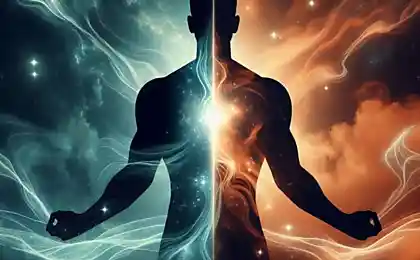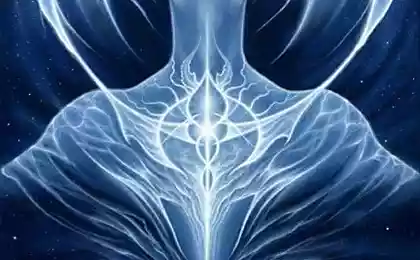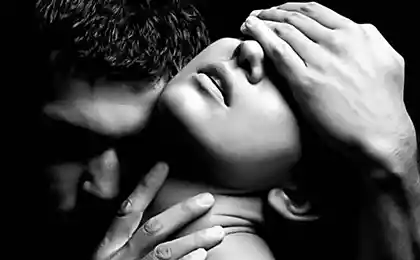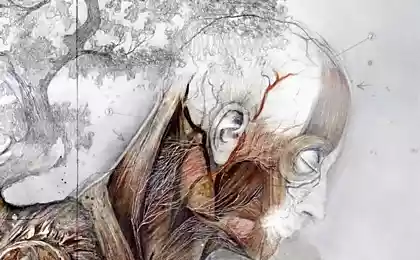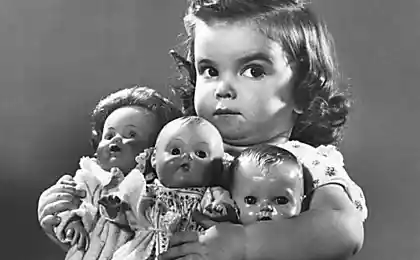285
The Anatomy of the Ego or Studying Yourself
Today we are talking about something that no one has ever seen, but regardless of beliefs and creeds, everyone recognizes its existence. We will use a number of images to talk about this invisible and mysterious object, which is commonly called the Ego, at the same time take a new look at some symbols, decipher some familiar words, interpret one of the Zen koans and read otherwise the well-known fairy tale.
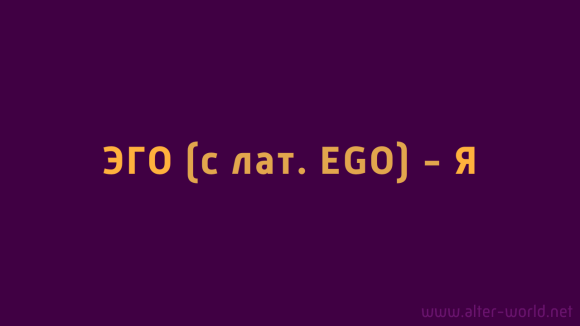
The term ego in the sense in which we use it is now quite young. It was used only in the 19th century and became popular thanks to Freud, Jung and other lesser-known figures of psychoanalysis and psychology. The term is taken from Latin and translated as “I”. In general, the ancients certainly understood the essence of many phenomena well, and to make sure of this it is enough to begin to examine words.
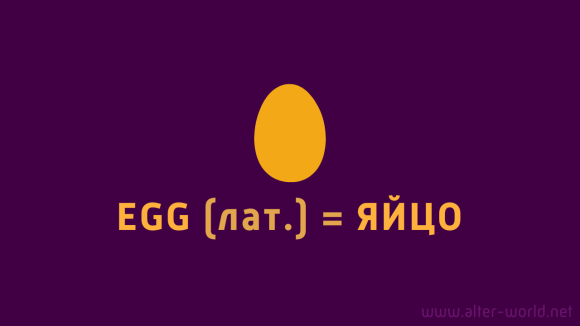
The word "ego" has the same root with the word "egg" (egg) and both words speak, on the one hand, of separation and isolation from the rest of the world, on the other - that this phenomenon is temporary, because inside the egg something ripens and must sooner or later hatch, leaving the shell.
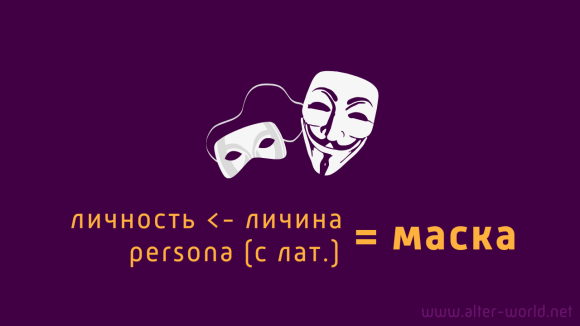
When we speak of a self, we mean a personality with all its attributes. Interestingly, the word “personality” (from the Old Slavonic “face”) in Russian and the word “persona” in Latin lead us to the same meaning – a mask. And again, we can see a similar meaning: a mask is something that hides us from reality, but also gives us a certain form, manifestation, individuality.
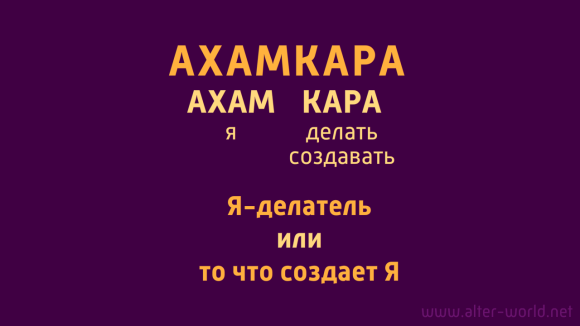
In the Vedic texts of ancient India, the word Ahamkara was used to denote a similar meaning. In Sanskrit, aham translates as me, and kara means to do or create. And the meaning of the word is this: "that which creates the feeling-I," or "the feeling of the I-doer." The Vedas call Ahamkara the false self.
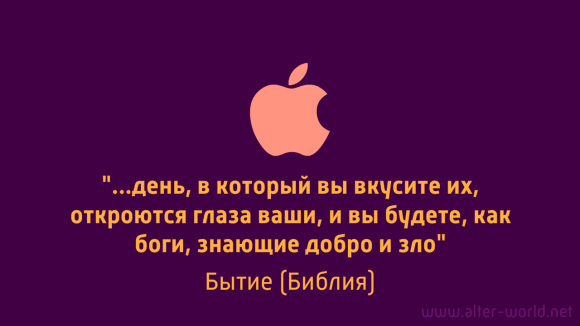
The basis of the feeling of separateness is the ability to distinguish. Distinction gives rise to concepts, which in turn give rise to many objects and phenomena. The Christian story of the Fall of Adam and Eve tells of the birth of the ability to discern and form concepts. The serpent says in the Garden of Eden, “The day you eat them, your eyes will be opened, and you will be like gods, knowing good and evil.”
Adam and Eve ate the forbidden fruit and were suddenly ashamed of their nakedness. This is the moment of the emergence of the idea of “I”, the moment of the birth of value thinking and dual perception: me and others. This is the original sin. The word sin is nothing but a mistake. To sin is to be wrong.
All religions and spiritual traditions point to this fundamental error of human perception. The mistake is not what we do, but who we think we are and what perceptions flow from it. The Buddhist term ignorance is just another word for this mistake. And this ignorance is passed down by mankind from one generation to the next. That is why Christianity speaks of the original sin of Adam and Eve, which affects all mankind.
(Now, by the way, you know what the Apple logo means.) Keywords hidden behind this brand: me, others, personality, duality, cognition, temptation.
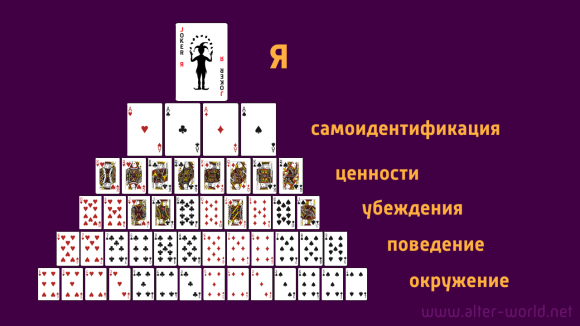
So, Ego. What is it and what does it consist of?
The answer may puzzle you: from everything you know.. The whole world is reflected in the human mind in the form of thoughts, concepts, images, feelings, states, ideas and concepts. And it's all linked together in one structure. At the physiological level, these are neural networks in the human brain. And there's not a single single neuron. The brain is one big network.
And at the conceptual level, we can think of all this as a kind of multi-level pyramid in which the whole content of our mind is located from the bottom up:
1) The environment is what surrounds us: the environment, material objects, people
2) Behavior is what we do.
(3) Beliefs are deliberate beliefs that we rely on to act on.
(4) Values — meaningful ideas, concepts and phenomena
(5) Self-identification is who we think we are.
6) "I."
Note that the “I” is represented as a Joker card. The Joker in the deck is a special card. The joke on this map represents an imitator parodying anything. The Joker card is able to replace any other card, any suit, adjust to any layout. It's her function in the deck. And this is the role of what we call “I.”
Each higher level defines all lower levels. And that's easy to see in our speech. Let me give you an example of statements: I am a patriot and I love my homeland. It's my duty to protect her. If necessary, I will defend her interests in the ranks of my comrades. In this passage, from top to bottom, all levels of the pyramid are involved. Or, "I'm a Buddhist." Compassion is an important aspect of the Buddhist worldview. Buddhism without compassion is unthinkable, so I practice selfless activities in orphanages and hospitals. ?
Note that the idea of “I” can be associated with every level, it is compatible with everything.
This structure is the main field of work on the spiritual path, but few people understand what to do with it.
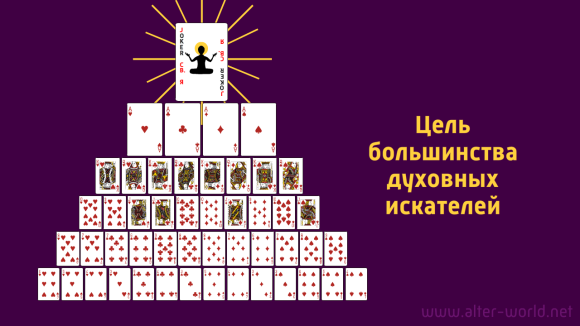
Most spiritual seekers have this vision of their goal: from the bottom up, good surroundings, useful deeds, positive beliefs, lofty values, spiritual roles, and above all this stands the transcendent “higher self” of the saint and the Buddha.
But in fact, only the coloring of the content has changed, not the structure. It is the structure that determines the ego, its boundaries and rigid construction. And as long as there is such a hierarchy, the main illusion remains, that original sin, or ignorance: me and others.
What do we mean when we talk about spirituality? The very word “spirituality” indicates this. It comes from the word Spirit. And most spiritual seekers have no idea what it is.
Where's the Spirit in this picture?
The pyramidal structure is all we know, the mind with all its contents. The mind is constantly in the process of becoming, and the Spirit is boundless, infinite and permanent. It's also called a non-mind or a non-me. It is outside the structure and at the same time permeates it.
There is no freedom within the structure. Spiritual seekers want freedom for the self, but true freedom is freedom from the self. The idea of “I” with which a person identifies himself is the main limitation. And until this is understood, you are doing anything but liberation, not awakening. Maybe you want to be a good and moral person, maybe you want to have superpowers, maybe you want to teach others, maybe you want love and bliss, maybe heaven or nirvana. But this isn't about liberation.
Everyone really wants something different. That’s why they get something different. This is the way the world works – all desires are fulfilled in it. Sooner or later. If you understand this, you just have to look at the facts: there are millions of spiritual seekers and there are only a few Buddhas. Not because it is very difficult to achieve, but because very few people really care about true awakening. People are more interested in getting something in a dream than waking up from it.
If spirituality is the realization of oneself as an eternal and infinite Spirit, then how do we get there?
Before proceeding to the consideration of different approaches, it is necessary to determine by what means the whole structure is retained.
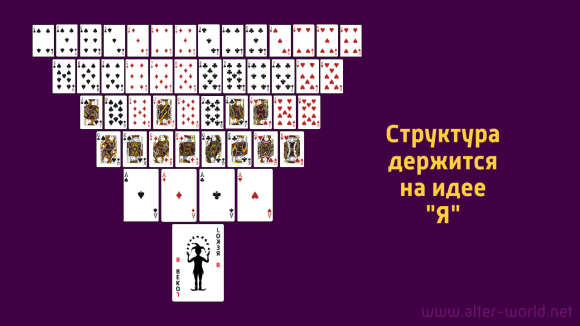
The image of the pyramid was intended to convey the subordination of the levels in our mind and to show that the idea of “I” rests on the entire contents of the mind. But at the same time, all the contents of the mind rest on the idea of “I.” And maintaining this structure requires a constant investment of energy. We feed the idea of the self directly or indirectly into every thought, every statement. Whatever we are talking about, we mean “I” as the subject with whom it happens. In essence, the idea of “I” holds the whole world together. Think about it mute. I'll repeat: As long as there is an "I" there is a world, there is no "I" statement, there is no peace. Do you want to see that easily? Go to bed. In a deep sleep you cease to affirm the idea of “I” and with it the whole world disappears.
Now let's look at different approaches. In India, a country of many religions and spiritual traditions, there are only two paths: the path of devotion (bhakti) and the path of wisdom (jnana). The rest are variations and combinations of the two. We will use this classification.
I immediately ask believers of different traditions to forgive me the abstract approach in presenting what many perceive sensually and emotionally.
141652
We all know different theistic religions (Christianity, Islam, Judaism, Vaishnavism, etc.). The key idea is God, and the key approach is devotion to God. In this case, God is represented as a person with certain qualities, characteristics and attributes.
There are two Jokers in every card deck. The first one we already know is the idea of “I”, compatible with any map, any suit, any layout. There is a second Joker in the life of a believer, the idea of God.
God is capable of the same things as I, he has the same powers, but he is also endowed with the qualities of omniscience, omnipotence, eternity and infinity. At first, God stands next to the self, and these two ideas compete with each other. But over time, the believer increasingly subordinates the whole structure to the idea of God. One day this idea becomes the main one, and even the idea of “I” begins to obey it.

At this stage, the believer asserts that everything is God’s will. And the idea of “I” in this structure begins to perform only the role of an intermediary.
Here we can mention the so-called Karma Yoga. Its main message is: “Act, but do not appropriate the fruits of this activity.” On the path of devotion, all merits and motives are attributed to God.
At this stage, a person becomes quite effective, easy, attractive in terms of human qualities, in which there are very few selfish tendencies. After all, the idea of “I” is no longer the support for the whole structure, it was replaced by the idea of God, as if lightening the heavy burden of a small person and releasing a considerable amount of energy.
For most believers, such people are role models and many of them are well-known teachers and preachers.
But this is not about eternity and infinity, nor about knowing the nature of reality. It's just about a new, higher level. People at this level talk about the Higher Self, God, Supermind. But it's still a structure, albeit at a higher level. There is still a subtle hold on the idea of “I”—the one who is loyal and the one who is betrayed.
The next stage on the path of devotion is the most difficult, it is performed by units.
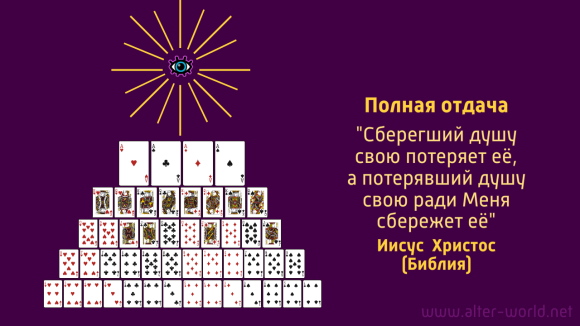
Why? Because you have to give up everything, surrender to God. It is necessary to abandon the idea of “I”, to abandon all values, beliefs, clinging to activities and objects of the material world. When this happens, the idea of God is abandoned, because it rests on the “I.” It can be said that beyond the structure the true God and the nature of reality are revealed.
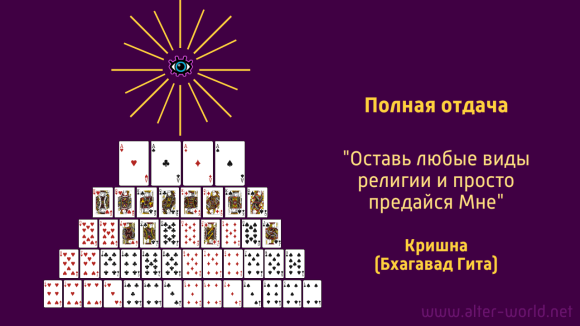
After complete dedication, the whole structure undergoes great changes, significant restructuring occurs, while those who realize themselves outside this structure cease to identify with it. We will talk about restructuring in the second way.
The Way of Wisdom. It can include the approaches of Buddhism, Advaita, Taoism. This path does not really need the idea of a God-personality. Buddhism does not speak of God. In Advata, the concept of God is impersonal. Their term Brahman, sometimes used to mean God, is essentially what we have defined as the infinite Spirit. The term Tao has a similar meaning.
The original message in them is that dual perception is the cause of human suffering, as well as the cause of ignorance of the true nature of reality. And the whole way comes down to eliminating that ignorance.
We use a new image that reflects the previous structure in a different way.
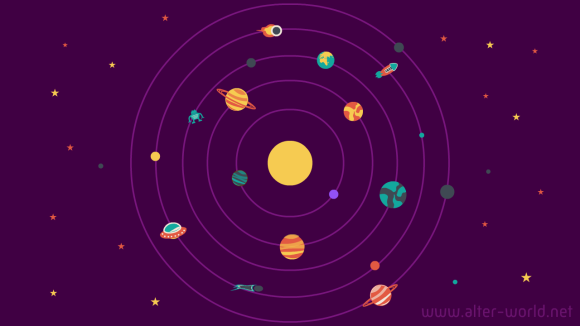
At the center of the main idea of the “I” is the Sun, around which all other objects of the mind (that is, all objects in the world) revolve. Each orbit is one of the levels we discussed. In the nearest orbit are our identities, our next values, then beliefs, then behavior and environment.
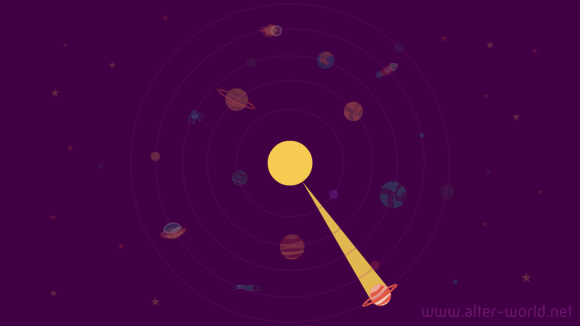
The dual perception of a person is arranged as follows: when we pay attention to one of the objects, all other objects at that moment cease to exist for us. This is how the mind works, its main function is identification with objects of perception. We first activate the object “I” (it is usually mistakenly called the subject), and then the object that we perceive at the moment, that is, two objects are always consistently activated. Hence the duality of perception.
So what do we need to do to move out of the limited structure into non-dual awareness beyond the limitations?
There are many methods and approaches, but I will take the liberty of reducing them to one strategy.
The main task is to get to the central object “I” to check what is behind it. For example, the question “Who am I?” can be used. Most spiritual seekers do not understand this. They think it's about new knowledge about themselves, but this question is different. It's about the nature of what we call "I." It is more understandable to ask this question: “What is I?”

Knowing yourself is just new information. Here was a regular nesting doll...

She changed her color when she learned something new about herself. New self-knowledge can affect your self-identity, values, beliefs, actions and environment. But all this will not affect the level of “I”.
It is not self-knowledge that is needed, but self-knowledge. And to know yourself, spiritual work is to cut off all that you are not, all that you hold onto.
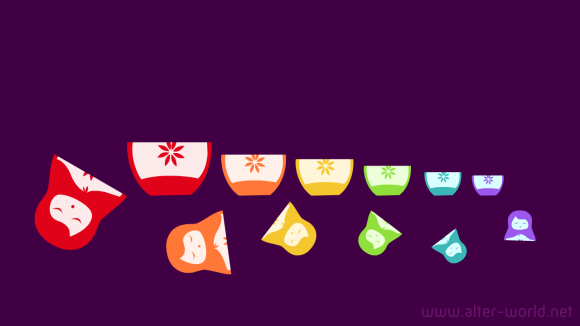
You shed all the layers, all the masks, all the things that hide the true nature of you and reality. You're doing it while there's nothing else to drop.
By the way, the word "matryoshka" is one root with the word "matter".
What is the main difficulty of this process? Only that we don't want to do it. For various reasons, all these layers and clothes are important to us. We are afraid to disappear, we are afraid of nothingness, we are afraid of losing everything that we consider important.
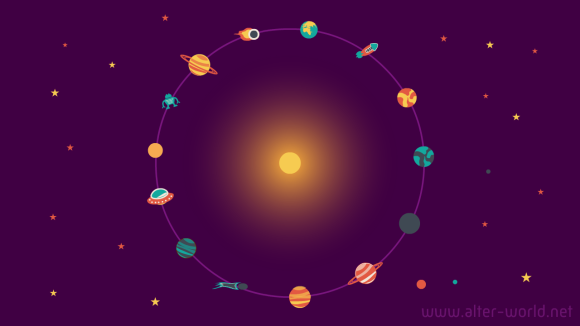
Spiritual work is about making all objects in the mind equally important. Then the idea of “I” will lose its reliance on other objects. When one object is no better than another, the energy between them is evenly distributed. The central object of the self is in a state of zero gravity and you find that there is nothing behind it. It is only an idea, a thought in which a person unconditionally believes, but never tests. Nothing more.
It is appropriate to mention the Buddhist Vipassana. This is what the practitioner of this meditation does. All objects in the mind are projected onto our body in the form of subtle and gross sensations. The meditator scans the body and observes without interfering or nourishing the sensations that appear with attention and energy. This reduces the significance of these sensations, and with them the objects in the mind that produce them.
When all sensations on the surface of the whole body feel the same, the body seems to disappear completely. This is one of the signs of the removal of one of the layers of unconscious attractions to objects. The practitioner of Vipassana is engaged in removing such layers.
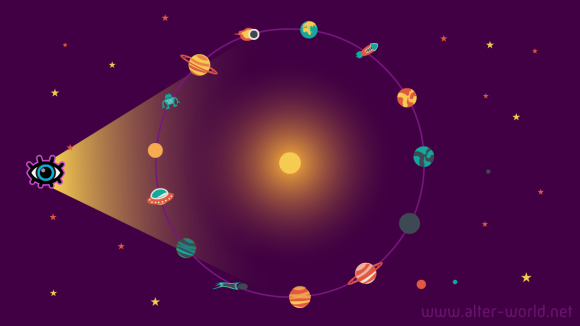
Once sensations, images, ideas, concepts cease to attract attention, leaving the sense of “I” in zero gravity. Then it turns out that there is someone else who is watching this “I.” And this one is boundless and present every moment of life, never disappeared, never appeared, never died or was born. And this is you, this is the real reality.
It is then discovered that the light of the sun (the central object of the self) has been reflected, and its source has always been beyond the structure of the mind.
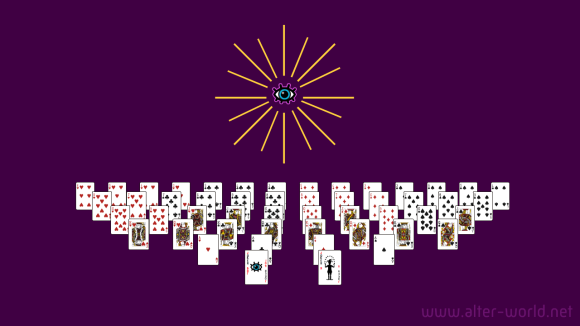
Now let's dispel one myth. Many people think that spiritual liberation is about the disappearance of the ego.
I can say unequivocally no, although I foresee mixed reactions to this. Spiritual liberation is the discovery of oneself beyond the ego-structure, but the structure itself remains. The idea of "I" too. You can't get anything out of your mind. Not a single object.
After going beyond the structure of the mind, it undergoes considerable changes and is greatly simplified, because now all objects in it are equally important. But it is thanks to the structure and idea of the “I” that man continues to live and act.
We have already said that the idea of “I,” the personality, the ego, is a mask, a role, a character. The ordinary person is identified with the roles he observes, but the awakened person is not. That's the difference. The awakened person knows that he is not a character on the stage, he is someone beyond it. And he doesn't know that intellectually. He realizes that every moment.
A person as an acting character is an embodied thought, an idea endowed with power. And the human body functions by constantly feeding this idea. To completely deprive it of energy means to stop using the body, which will lead to the deprivation of its vitality, withering and, as a result, death.
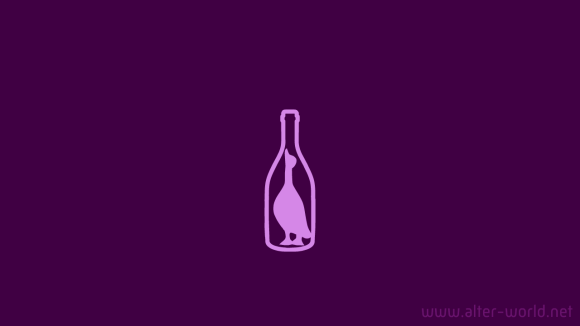
In Zen Buddhism, koans are used as paradoxical puzzles or themes for reflection. They are used as a drill to penetrate deep layers. One of them is this:
A small caterpillar was placed in a bottle. Then he grew up and became too small. How to get a goose out of a bottle without breaking a bottle?
After all this, you need to understand the context of this mystery. In our context, the question is, how do we go beyond the structure without breaking the structure? How do you free yourself?
The Zen answer is no, the goose is already outside.
320362
That's what we were talking about. The true nature of each of us is eternal and does not belong to the structure. And note that the task insists on saving the bottle.
To develop this image, human life is like this: the goose looks into the bottle and sees its reflection at the bottom. And he thinks he's inside.
It is also worth mentioning that what is the structure of the ego is the structure of society. We project the structure of the ego throughout our lives, and it is no wonder that society has the same structure. Remember the pyramid structure? It was meant to remind you of something (meaning the New World Order). Class inequality, high hierarchies, and subordination are when some are more important than others.
I'm sure we're living in an unusual time. This is a time of great change, a time when some will choose to change the structure of the ego, and others will have to do so due to the circumstances. This will affect almost all of humanity. I believe that a society with a current structure is living through the last days. And he will face a serious social crisis and the subsequent collapse of the structure.
And I'll tell you:Crisis is good. The crisis shows that we have reached a new level.
And finally, I'll tell you a story that you all know. It's a fairy tale called "Rab Chicken." In the context of our communication, I take this tale as a prophecy. The symbols should be clear to you by now.

Once upon a time, there was grandpa. They had chicken poop. The chicken laid the testicle, not simple - gold. Grandpa beat, beat, didn't break. Baba beat, beat, didn't break. The mouse ran, hit the tail, the testicle fell and broke. Grandpa cries, the woman cries, and the chicken cackles:
Don't cry, Grandpa, don't cry, Grandma: I'll lay you a testicle not golden - simple!
Remember this fairy tale, and if suddenly there will be times of a great universal crisis, remember it and understand what to do. Leave clinging to the golden testicle and choose a simpler testicle.
This is the next step in human society -- horizontal structures instead of vertical structures.
But it is even better not to wait for the crisis to unfold outside, but to see that it has already come, and it would be time to grow up.
P.S. And remember, just changing your understanding – together we change the world!
Source: alter-world.net/2014/11/07/anatomiya-ego/

The term ego in the sense in which we use it is now quite young. It was used only in the 19th century and became popular thanks to Freud, Jung and other lesser-known figures of psychoanalysis and psychology. The term is taken from Latin and translated as “I”. In general, the ancients certainly understood the essence of many phenomena well, and to make sure of this it is enough to begin to examine words.

The word "ego" has the same root with the word "egg" (egg) and both words speak, on the one hand, of separation and isolation from the rest of the world, on the other - that this phenomenon is temporary, because inside the egg something ripens and must sooner or later hatch, leaving the shell.

When we speak of a self, we mean a personality with all its attributes. Interestingly, the word “personality” (from the Old Slavonic “face”) in Russian and the word “persona” in Latin lead us to the same meaning – a mask. And again, we can see a similar meaning: a mask is something that hides us from reality, but also gives us a certain form, manifestation, individuality.

In the Vedic texts of ancient India, the word Ahamkara was used to denote a similar meaning. In Sanskrit, aham translates as me, and kara means to do or create. And the meaning of the word is this: "that which creates the feeling-I," or "the feeling of the I-doer." The Vedas call Ahamkara the false self.

The basis of the feeling of separateness is the ability to distinguish. Distinction gives rise to concepts, which in turn give rise to many objects and phenomena. The Christian story of the Fall of Adam and Eve tells of the birth of the ability to discern and form concepts. The serpent says in the Garden of Eden, “The day you eat them, your eyes will be opened, and you will be like gods, knowing good and evil.”
Adam and Eve ate the forbidden fruit and were suddenly ashamed of their nakedness. This is the moment of the emergence of the idea of “I”, the moment of the birth of value thinking and dual perception: me and others. This is the original sin. The word sin is nothing but a mistake. To sin is to be wrong.
All religions and spiritual traditions point to this fundamental error of human perception. The mistake is not what we do, but who we think we are and what perceptions flow from it. The Buddhist term ignorance is just another word for this mistake. And this ignorance is passed down by mankind from one generation to the next. That is why Christianity speaks of the original sin of Adam and Eve, which affects all mankind.
(Now, by the way, you know what the Apple logo means.) Keywords hidden behind this brand: me, others, personality, duality, cognition, temptation.

So, Ego. What is it and what does it consist of?
The answer may puzzle you: from everything you know.. The whole world is reflected in the human mind in the form of thoughts, concepts, images, feelings, states, ideas and concepts. And it's all linked together in one structure. At the physiological level, these are neural networks in the human brain. And there's not a single single neuron. The brain is one big network.
And at the conceptual level, we can think of all this as a kind of multi-level pyramid in which the whole content of our mind is located from the bottom up:
1) The environment is what surrounds us: the environment, material objects, people
2) Behavior is what we do.
(3) Beliefs are deliberate beliefs that we rely on to act on.
(4) Values — meaningful ideas, concepts and phenomena
(5) Self-identification is who we think we are.
6) "I."
Note that the “I” is represented as a Joker card. The Joker in the deck is a special card. The joke on this map represents an imitator parodying anything. The Joker card is able to replace any other card, any suit, adjust to any layout. It's her function in the deck. And this is the role of what we call “I.”
Each higher level defines all lower levels. And that's easy to see in our speech. Let me give you an example of statements: I am a patriot and I love my homeland. It's my duty to protect her. If necessary, I will defend her interests in the ranks of my comrades. In this passage, from top to bottom, all levels of the pyramid are involved. Or, "I'm a Buddhist." Compassion is an important aspect of the Buddhist worldview. Buddhism without compassion is unthinkable, so I practice selfless activities in orphanages and hospitals. ?
Note that the idea of “I” can be associated with every level, it is compatible with everything.
This structure is the main field of work on the spiritual path, but few people understand what to do with it.

Most spiritual seekers have this vision of their goal: from the bottom up, good surroundings, useful deeds, positive beliefs, lofty values, spiritual roles, and above all this stands the transcendent “higher self” of the saint and the Buddha.
But in fact, only the coloring of the content has changed, not the structure. It is the structure that determines the ego, its boundaries and rigid construction. And as long as there is such a hierarchy, the main illusion remains, that original sin, or ignorance: me and others.
What do we mean when we talk about spirituality? The very word “spirituality” indicates this. It comes from the word Spirit. And most spiritual seekers have no idea what it is.
Where's the Spirit in this picture?
The pyramidal structure is all we know, the mind with all its contents. The mind is constantly in the process of becoming, and the Spirit is boundless, infinite and permanent. It's also called a non-mind or a non-me. It is outside the structure and at the same time permeates it.
There is no freedom within the structure. Spiritual seekers want freedom for the self, but true freedom is freedom from the self. The idea of “I” with which a person identifies himself is the main limitation. And until this is understood, you are doing anything but liberation, not awakening. Maybe you want to be a good and moral person, maybe you want to have superpowers, maybe you want to teach others, maybe you want love and bliss, maybe heaven or nirvana. But this isn't about liberation.
Everyone really wants something different. That’s why they get something different. This is the way the world works – all desires are fulfilled in it. Sooner or later. If you understand this, you just have to look at the facts: there are millions of spiritual seekers and there are only a few Buddhas. Not because it is very difficult to achieve, but because very few people really care about true awakening. People are more interested in getting something in a dream than waking up from it.
If spirituality is the realization of oneself as an eternal and infinite Spirit, then how do we get there?
Before proceeding to the consideration of different approaches, it is necessary to determine by what means the whole structure is retained.

The image of the pyramid was intended to convey the subordination of the levels in our mind and to show that the idea of “I” rests on the entire contents of the mind. But at the same time, all the contents of the mind rest on the idea of “I.” And maintaining this structure requires a constant investment of energy. We feed the idea of the self directly or indirectly into every thought, every statement. Whatever we are talking about, we mean “I” as the subject with whom it happens. In essence, the idea of “I” holds the whole world together. Think about it mute. I'll repeat: As long as there is an "I" there is a world, there is no "I" statement, there is no peace. Do you want to see that easily? Go to bed. In a deep sleep you cease to affirm the idea of “I” and with it the whole world disappears.
Now let's look at different approaches. In India, a country of many religions and spiritual traditions, there are only two paths: the path of devotion (bhakti) and the path of wisdom (jnana). The rest are variations and combinations of the two. We will use this classification.
I immediately ask believers of different traditions to forgive me the abstract approach in presenting what many perceive sensually and emotionally.
141652
We all know different theistic religions (Christianity, Islam, Judaism, Vaishnavism, etc.). The key idea is God, and the key approach is devotion to God. In this case, God is represented as a person with certain qualities, characteristics and attributes.
There are two Jokers in every card deck. The first one we already know is the idea of “I”, compatible with any map, any suit, any layout. There is a second Joker in the life of a believer, the idea of God.
God is capable of the same things as I, he has the same powers, but he is also endowed with the qualities of omniscience, omnipotence, eternity and infinity. At first, God stands next to the self, and these two ideas compete with each other. But over time, the believer increasingly subordinates the whole structure to the idea of God. One day this idea becomes the main one, and even the idea of “I” begins to obey it.

At this stage, the believer asserts that everything is God’s will. And the idea of “I” in this structure begins to perform only the role of an intermediary.
Here we can mention the so-called Karma Yoga. Its main message is: “Act, but do not appropriate the fruits of this activity.” On the path of devotion, all merits and motives are attributed to God.
At this stage, a person becomes quite effective, easy, attractive in terms of human qualities, in which there are very few selfish tendencies. After all, the idea of “I” is no longer the support for the whole structure, it was replaced by the idea of God, as if lightening the heavy burden of a small person and releasing a considerable amount of energy.
For most believers, such people are role models and many of them are well-known teachers and preachers.
But this is not about eternity and infinity, nor about knowing the nature of reality. It's just about a new, higher level. People at this level talk about the Higher Self, God, Supermind. But it's still a structure, albeit at a higher level. There is still a subtle hold on the idea of “I”—the one who is loyal and the one who is betrayed.
The next stage on the path of devotion is the most difficult, it is performed by units.

Why? Because you have to give up everything, surrender to God. It is necessary to abandon the idea of “I”, to abandon all values, beliefs, clinging to activities and objects of the material world. When this happens, the idea of God is abandoned, because it rests on the “I.” It can be said that beyond the structure the true God and the nature of reality are revealed.

After complete dedication, the whole structure undergoes great changes, significant restructuring occurs, while those who realize themselves outside this structure cease to identify with it. We will talk about restructuring in the second way.
The Way of Wisdom. It can include the approaches of Buddhism, Advaita, Taoism. This path does not really need the idea of a God-personality. Buddhism does not speak of God. In Advata, the concept of God is impersonal. Their term Brahman, sometimes used to mean God, is essentially what we have defined as the infinite Spirit. The term Tao has a similar meaning.
The original message in them is that dual perception is the cause of human suffering, as well as the cause of ignorance of the true nature of reality. And the whole way comes down to eliminating that ignorance.
We use a new image that reflects the previous structure in a different way.

At the center of the main idea of the “I” is the Sun, around which all other objects of the mind (that is, all objects in the world) revolve. Each orbit is one of the levels we discussed. In the nearest orbit are our identities, our next values, then beliefs, then behavior and environment.

The dual perception of a person is arranged as follows: when we pay attention to one of the objects, all other objects at that moment cease to exist for us. This is how the mind works, its main function is identification with objects of perception. We first activate the object “I” (it is usually mistakenly called the subject), and then the object that we perceive at the moment, that is, two objects are always consistently activated. Hence the duality of perception.
So what do we need to do to move out of the limited structure into non-dual awareness beyond the limitations?
There are many methods and approaches, but I will take the liberty of reducing them to one strategy.
The main task is to get to the central object “I” to check what is behind it. For example, the question “Who am I?” can be used. Most spiritual seekers do not understand this. They think it's about new knowledge about themselves, but this question is different. It's about the nature of what we call "I." It is more understandable to ask this question: “What is I?”

Knowing yourself is just new information. Here was a regular nesting doll...

She changed her color when she learned something new about herself. New self-knowledge can affect your self-identity, values, beliefs, actions and environment. But all this will not affect the level of “I”.
It is not self-knowledge that is needed, but self-knowledge. And to know yourself, spiritual work is to cut off all that you are not, all that you hold onto.

You shed all the layers, all the masks, all the things that hide the true nature of you and reality. You're doing it while there's nothing else to drop.
By the way, the word "matryoshka" is one root with the word "matter".
What is the main difficulty of this process? Only that we don't want to do it. For various reasons, all these layers and clothes are important to us. We are afraid to disappear, we are afraid of nothingness, we are afraid of losing everything that we consider important.

Spiritual work is about making all objects in the mind equally important. Then the idea of “I” will lose its reliance on other objects. When one object is no better than another, the energy between them is evenly distributed. The central object of the self is in a state of zero gravity and you find that there is nothing behind it. It is only an idea, a thought in which a person unconditionally believes, but never tests. Nothing more.
It is appropriate to mention the Buddhist Vipassana. This is what the practitioner of this meditation does. All objects in the mind are projected onto our body in the form of subtle and gross sensations. The meditator scans the body and observes without interfering or nourishing the sensations that appear with attention and energy. This reduces the significance of these sensations, and with them the objects in the mind that produce them.
When all sensations on the surface of the whole body feel the same, the body seems to disappear completely. This is one of the signs of the removal of one of the layers of unconscious attractions to objects. The practitioner of Vipassana is engaged in removing such layers.

Once sensations, images, ideas, concepts cease to attract attention, leaving the sense of “I” in zero gravity. Then it turns out that there is someone else who is watching this “I.” And this one is boundless and present every moment of life, never disappeared, never appeared, never died or was born. And this is you, this is the real reality.
It is then discovered that the light of the sun (the central object of the self) has been reflected, and its source has always been beyond the structure of the mind.

Now let's dispel one myth. Many people think that spiritual liberation is about the disappearance of the ego.
I can say unequivocally no, although I foresee mixed reactions to this. Spiritual liberation is the discovery of oneself beyond the ego-structure, but the structure itself remains. The idea of "I" too. You can't get anything out of your mind. Not a single object.
After going beyond the structure of the mind, it undergoes considerable changes and is greatly simplified, because now all objects in it are equally important. But it is thanks to the structure and idea of the “I” that man continues to live and act.
We have already said that the idea of “I,” the personality, the ego, is a mask, a role, a character. The ordinary person is identified with the roles he observes, but the awakened person is not. That's the difference. The awakened person knows that he is not a character on the stage, he is someone beyond it. And he doesn't know that intellectually. He realizes that every moment.
A person as an acting character is an embodied thought, an idea endowed with power. And the human body functions by constantly feeding this idea. To completely deprive it of energy means to stop using the body, which will lead to the deprivation of its vitality, withering and, as a result, death.

In Zen Buddhism, koans are used as paradoxical puzzles or themes for reflection. They are used as a drill to penetrate deep layers. One of them is this:
A small caterpillar was placed in a bottle. Then he grew up and became too small. How to get a goose out of a bottle without breaking a bottle?
After all this, you need to understand the context of this mystery. In our context, the question is, how do we go beyond the structure without breaking the structure? How do you free yourself?
The Zen answer is no, the goose is already outside.
320362
That's what we were talking about. The true nature of each of us is eternal and does not belong to the structure. And note that the task insists on saving the bottle.
To develop this image, human life is like this: the goose looks into the bottle and sees its reflection at the bottom. And he thinks he's inside.
It is also worth mentioning that what is the structure of the ego is the structure of society. We project the structure of the ego throughout our lives, and it is no wonder that society has the same structure. Remember the pyramid structure? It was meant to remind you of something (meaning the New World Order). Class inequality, high hierarchies, and subordination are when some are more important than others.
I'm sure we're living in an unusual time. This is a time of great change, a time when some will choose to change the structure of the ego, and others will have to do so due to the circumstances. This will affect almost all of humanity. I believe that a society with a current structure is living through the last days. And he will face a serious social crisis and the subsequent collapse of the structure.
And I'll tell you:Crisis is good. The crisis shows that we have reached a new level.
And finally, I'll tell you a story that you all know. It's a fairy tale called "Rab Chicken." In the context of our communication, I take this tale as a prophecy. The symbols should be clear to you by now.

Once upon a time, there was grandpa. They had chicken poop. The chicken laid the testicle, not simple - gold. Grandpa beat, beat, didn't break. Baba beat, beat, didn't break. The mouse ran, hit the tail, the testicle fell and broke. Grandpa cries, the woman cries, and the chicken cackles:
Don't cry, Grandpa, don't cry, Grandma: I'll lay you a testicle not golden - simple!
Remember this fairy tale, and if suddenly there will be times of a great universal crisis, remember it and understand what to do. Leave clinging to the golden testicle and choose a simpler testicle.
This is the next step in human society -- horizontal structures instead of vertical structures.
But it is even better not to wait for the crisis to unfold outside, but to see that it has already come, and it would be time to grow up.
P.S. And remember, just changing your understanding – together we change the world!
Source: alter-world.net/2014/11/07/anatomiya-ego/
